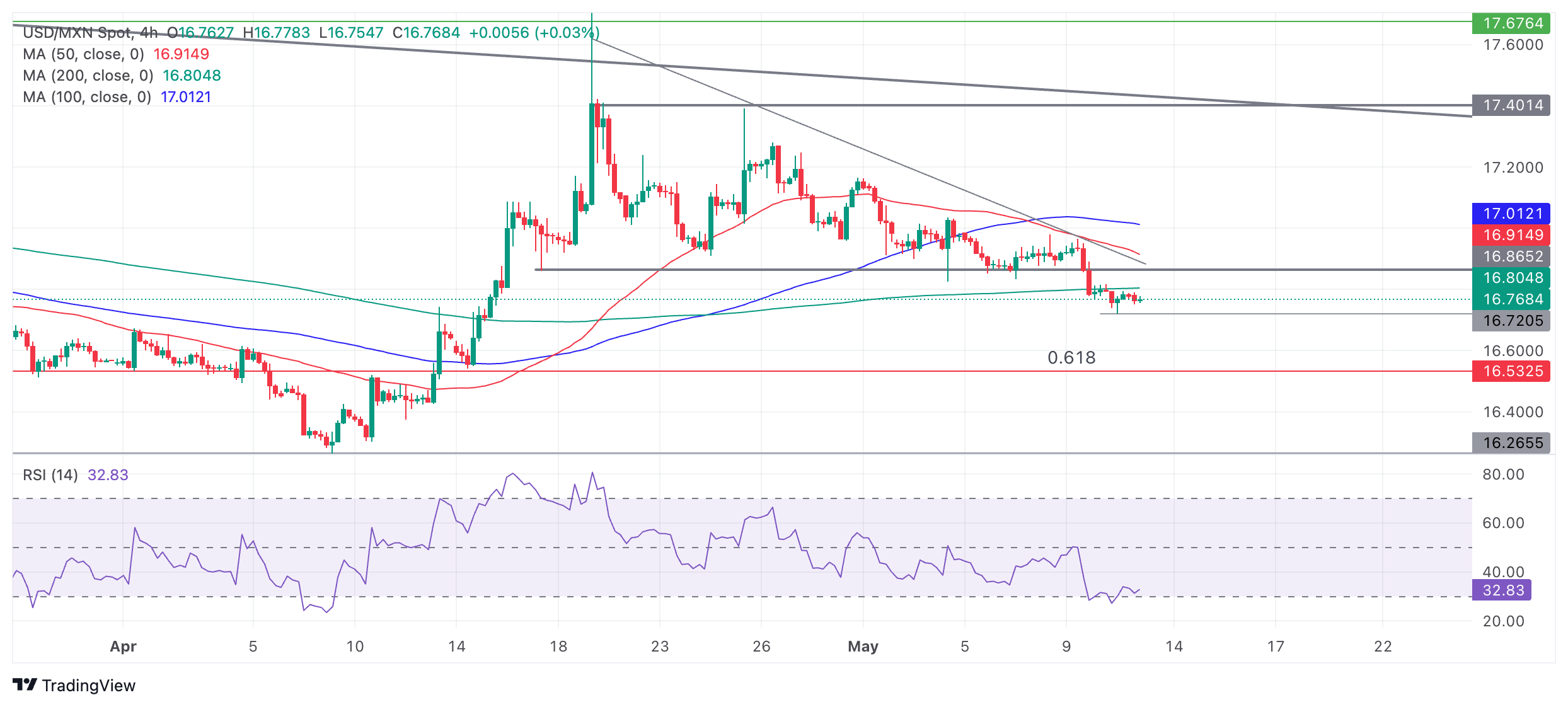Mexican Peso makes modest gains on favorable interest rate outlook

- The Mexican Peso edges higher as interest rates in Mexico are expected to remain elevated.
- Relatively higher interest rates attract higher inflows of foreign capital.
- USD/MXN consolidates in its downtrend after a breakout. More downside is expected.
The Mexican Peso (MXN) trades slightly higher in its major pairs on Monday, continuing to benefit from relatively higher interest rate expectations in Mexico following last week’s central bank decision.
USD/MXN is exchanging hands at 16.76, EUR/MXN at 18.06 and GBP/MXN at 21.01, at the time of publication.
Mexican Peso edges higher on interest rate expectations
The Mexican Peso trades higher, on the back of favorable interest rate expectations – a major driver of FX, where funds tend to flow to countries with higher interest rates.
At the Bank of Mexico (Banxico) meeting last Thursday, the central bank decided to leave its policy rate unchanged at 11.00% after cutting by 0.25% in March. It cited persistent inflation as the reason for not cutting again, leading to a rebound in the Peso.
The central bank also upwardly revised its inflation forecasts for the next six quarters, which indicates it sees an environment of sustained inflationary pressures ahead. This makes it less likely to lower interest rates in the short-term, further supporting the Mexican Peso.
Technical Analysis: USD/MXN consolidates within a down trend
USD/MXN – the value of one US Dollar in Mexican Pesos – decisively broke below the bottom of a short-term range at 16.86 last week, reflecting the continued strengthening of the Mexican Peso.
The breakout of the range – which could also possibly be interpreted as a descending triangle pattern – was a decisive technical development that suggests a protracted move lower.
USD/MXN 4-hour Chart
A conservative target for the breakout lies at 16.54, the 0.681 Fibonacci ratio of the height of the range extrapolated lower. This is followed by 16.34, the full height of the range extrapolated lower.
The short-term trend is now probably bearish following the breakdown from the range, which, given the old adage that the “trend is your friend”, suggests the odds favor continued downside.
However, the current move is temporarily oversold according to the Relative Strength Index (RSI). The RSI dipped into oversold territory on Friday and has since risen back out. This gives a short-term buy signal and suggests a pull back or sideways consolidation could be underway.
However, the pair is expected to eventually continue its march lower given the breakout from the range and the dominant downtrend. A break below 16.72 would confirm a continuation south.
Given the medium and long-term trends are bearish, the odds further favor more downside for the pair in line with those trends.
Mexican Peso FAQs
The Mexican Peso (MXN) is the most traded currency among its Latin American peers. Its value is broadly determined by the performance of the Mexican economy, the country’s central bank’s policy, the amount of foreign investment in the country and even the levels of remittances sent by Mexicans who live abroad, particularly in the United States. Geopolitical trends can also move MXN: for example, the process of nearshoring – or the decision by some firms to relocate manufacturing capacity and supply chains closer to their home countries – is also seen as a catalyst for the Mexican currency as the country is considered a key manufacturing hub in the American continent. Another catalyst for MXN is Oil prices as Mexico is a key exporter of the commodity.
The main objective of Mexico’s central bank, also known as Banxico, is to maintain inflation at low and stable levels (at or close to its target of 3%, the midpoint in a tolerance band of between 2% and 4%). To this end, the bank sets an appropriate level of interest rates. When inflation is too high, Banxico will attempt to tame it by raising interest rates, making it more expensive for households and businesses to borrow money, thus cooling demand and the overall economy. Higher interest rates are generally positive for the Mexican Peso (MXN) as they lead to higher yields, making the country a more attractive place for investors. On the contrary, lower interest rates tend to weaken MXN.
Macroeconomic data releases are key to assess the state of the economy and can have an impact on the Mexican Peso (MXN) valuation. A strong Mexican economy, based on high economic growth, low unemployment and high confidence is good for MXN. Not only does it attract more foreign investment but it may encourage the Bank of Mexico (Banxico) to increase interest rates, particularly if this strength comes together with elevated inflation. However, if economic data is weak, MXN is likely to depreciate.
As an emerging-market currency, the Mexican Peso (MXN) tends to strive during risk-on periods, or when investors perceive that broader market risks are low and thus are eager to engage with investments that carry a higher risk. Conversely, MXN tends to weaken at times of market turbulence or economic uncertainty as investors tend to sell higher-risk assets and flee to the more-stable safe havens.
